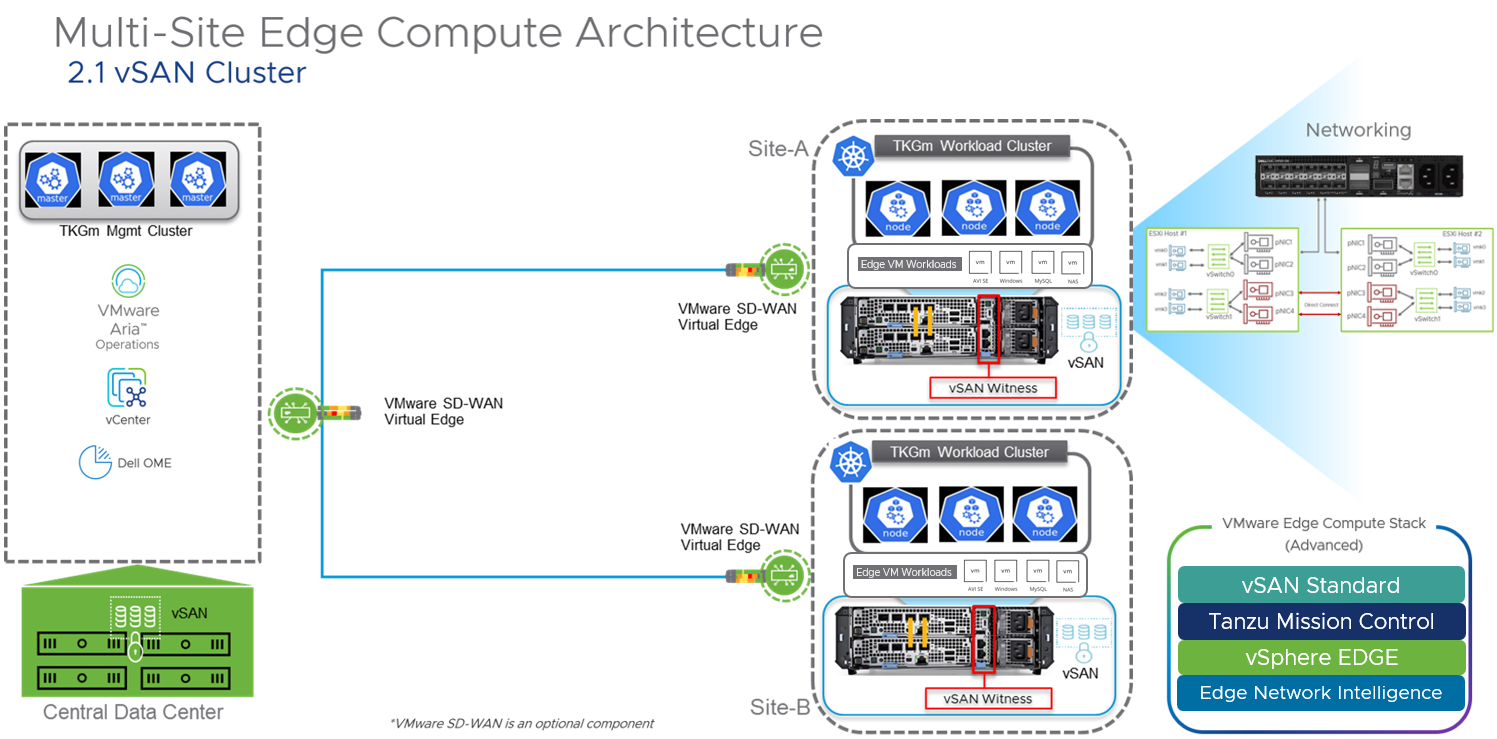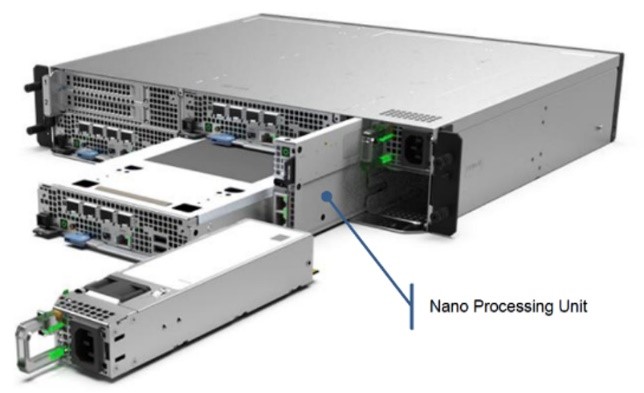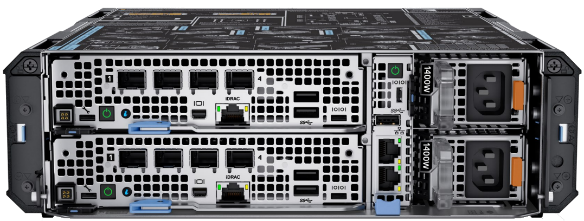

Deploy HCI with Ease on VMware vSAN Ready Nodes™
Download PDFTue, 17 Jan 2023 06:59:21 -0000
|Read Time: 0 minutes
Summary
Hyperconverged infrastructure is changing the way that IT organizations deliver resources to their users. In this short joint reference document with Dell Technologies and Intel we discuss the critical hardware components needed to successfully deploy vSAN. The information in this publication is provided as is. Dell Inc. makes no representations or warranties of any kind with respect to the information in this publication, and specifically disclaims implied warranties of merchantability or fitness for a particular purpose.
The surge in remote work and virtual desktop infrastructure (VDI) is increasing resource demands in the data center. As a result, many enterprises are turning to hyperconverged infrastructure (HCI). But HCI implementation can be complex and time-consuming. VMware vSAN ReadyNode™ provides a turnkey solution for accelerating HCI.
vSAN ReadyNode is a validated configuration on Dell EMC™ PowerEdge™ servers. These servers are tested and certified for VMware vSAN™ deployment, jointly recommended by Dell and VMware. vSAN ReadyNode on Dell EMC PowerEdge servers can help reduce HCI complexity, decrease total cost of ownership (TCO), scale with business needs and accommodate hybrid-cloud solutions such as VMware Cloud Foundation™. Benefits include the following:
- License efficiency—Get the most from each software license. vSAN ReadyNode on Dell EMC PowerEdge servers is designed to provide the best performance for each VMware® license per 32-core socket.
- High throughput—Elastic, scalable storage is one of many vSAN benefits. vSAN ReadyNode on Dell EMC PowerEdge servers, built on high-performing Intel architecture, prioritizes storage throughput with fast write caching and capacity storage tiers.
- Low latency—As a vSAN deployment grows, and data needs to be accessed across the cluster, data-access response times become increasingly important. This architecture, featuring Intel Ethernet Network Adapters, takes advantage of VMware’s recent addition of remote direct memory access (RDMA) to improve data response and user experience.
Key Considerations
- Available in two configurations—Both the “Base” and “Plus” configurations use similar all-flash NVM Express® (NVMe®) storage configurations. However, the Plus configuration is equipped with a higher-frequency CPU and Intel® Optane™ persistent memory (PMem). Both configurations are based on Intel® Select Solutions for VMware vSAN 7 HCI with 3rd Generation Intel® Xeon® Scalable processors.
- Networking—Both configurations are equipped with RDMA-capable Intel® Ethernet 800 Series network adapters that accelerate vSAN 7 performance (7.0 U2 or later). The Intel Ethernet Network Adapter E810- XXV network interface controller (NIC) can be used for network- and storage-intensive workloads requiring more than 25 gigabits per second (Gbps) of bandwidth.
- Rack-space requirements—The rack-space-optimized Dell EMC PowerEdge R650 server–based system can be used if large storage capacity is not needed (up to two storage groups are supported, each with a single cache drive and up to four capacity drives, with a maximum of 10 NVMe drives per system). For more drives or future- capacity scaling, the Dell EMC PowerEdge R750 server–based system is recommended.
Available Configurations
| Base configuration | Plus configuration | ||
Platform | Dell EMC™ PowerEdge™ R650, supporting 10 NVMe® drives (direct connection with no Dell™ PowerEdge RAID Controller [PERC]), 1RU | Dell EMC PowerEdge R750, supporting 24 NVMe drives (direct connection with no Dell PERC), 2RU | Dell EMC PowerEdge R650 supporting 10 NVMe drives (direct connection with no Dell PERC), 1RU | Dell EMC PowerEdge R750 supporting 24 NVMe drives (direct connection with no Dell PERC), 2RU |
CPU | 2 x Intel® Xeon® Gold 6338 processor (32 cores at 2.0 GHz) | 2 x Intel® Xeon® Platinum 8358 processor (32 cores at 2.6 GHz) or 2 x Intel® Xeon® Platinum 8362 processor (32 cores at 2.8 GHz) | ||
DRAM | 512 GB (16 x 32 GB DDR4-3200) | 256 GB (16 x 16 GB DDR4-3200) | ||
Persistent Memory | Optional | 1 TB (8 x 128 GB Intel® Optane™ PMem 200 series) | ||
Boot device | Dell EMC™ Boot Optimized Server Storage (BOSS)-S2 with 2 x 480 GB Intel® SSD S4510 M.2 Serial ATA (SATA) (RAID1) | |||
Storage adapter | Not required for an all-NVMe configuration | |||
Cache tier drives | 2 x 400 GB Intel Optane SSD P5800X (PCIe Gen4) or 2 x 375 GB Intel Optane SSD DC P4800X (PCIe Gen3)i | |||
Capacity tier drives | 6 x (up to 8 x) 3.84 TB Intel SSD DC P5500 (PCIe Gen4, read- intensive) | 6 x (up to 12 x) 3.84 TB Intel SSD DC P5500 (PCIe Gen4, read- intensive) | 6 x (up to 8 x) 3.84 TB Intel SSD DC P5500 (PCIe Gen4, read- intensive) | 6 x (up to 12 x) 3.84 TB Intel SSD DC P5500 (PCIe Gen4, read-intensive) |
NIC | Intel® Ethernet Network Adapter E810-XXV for OCP3 (dual-port 25 Gb)ii | |||
Get Started
View the vSAN Hardware Quick Reference Guide and VMware Compatibility Guide.
Learn More
- Contact your Dell or Intel account team. 1-877-289+-3355
- Read the Principled Technologies report: Reap better SQL Server OLTP performance with next-generation Dell EMC PowerEdge MX servers.
- Read the science behind the Principled Technologies report.
- View the Principled Technologies infographic.
i The Intel® Optane™ SSD P5800X is recommended, but the previous-generation Intel Optane SSD DC P4800X can be used instead if the Intel Optane SSD P5800X is not yet available.
ii When used with VMware vSAN™, the Intel® Ethernet Network Adapter E810-XXV for OCP3 requires appropriate RDMA firmware.
Related Documents

Dell PowerEdge XR4000 with VMware Edge Compute Stack for Edge Computing
Thu, 31 Aug 2023 17:42:58 -0000
|Read Time: 0 minutes

Overview
Enterprises want to build and operate applications that have low latency requirements to process and analyze real-time data, and they want to provide intelligence for smarter decision-making at the edge. However, they face many challenges: aging infrastructure, limited edge-computing resources, environmental factors, and lack of IT staff to deploy and support applications across many edge sites.
This document provides an overview of a combined edge platform built on Dell PowerEdge XR servers and VMware Edge Compute Stack to solve these challenges. It describes key use cases in retail, manufacturing, and other industries.
The PowerEdge XR server series is built to capture and process more data at the edge, with enterprise-grade compute abilities providing high performance with low latency for the edge. The XR servers can withstand unpredictable and challenging deployment environments. XR4000 is the new high-performance multi-node XR server, purpose-built for ultra-short depth and low power, and with flexible configurations. These configurations are also available on our Dell vSAN Ready Nodes.
- 1S Intel® Ice Lake Xeon-D® with integrated security and cyber-resilient architecture
- 355-mm-deep chassis with wall-mount option
- Rugged operating range from –5°C to 55°C (32°F to 131°F)
- Flexible 1U and 2U compute sled; self-contained 2-node for VMware vSAN cluster
Edge Compute Stack (ECS) is a fully integrated edge platform for customers with many edge sites. ECS empowers IT and OT to deliver intelligent real-time solutions, offering flexibility, consistency, security, and extensibility:
- Flexibility to run virtual and container applications, standard and real-time operating systems
- Consistent interoperability across edges, data centers, and clouds
- Security to protect applications, users, devices, and data against threats
- Open platform that offers component choices and extensibility
This document includes a combined XR4000 and ECS reference architecture validated and supported by Dell Technologies and VMware. It also provides sample configurations for customers and partners to use as a starting point to design and implement the combined edge platform.
Customer use cases
Key use cases for the solution are in the retail, manufacturing, and government sectors.
Retail
Retailers adapted to the pandemic with increased use of self-service checkout and new delivery mechanisms. They are deploying edge applications to improve customer experience and profitability:
- Self-checkout—Camera and computer vision solutions help prevent loss from missed scans and switched products or price stickers by instantaneously matching products with prices.
- Optimal shelf provisioning—Inventory tracking and data analysis solutions can optimize shelf-provisioning to increase sales.
- Immersive experience—Interactive mirrors in apparel stores give customers an immersive experience when they are trying out an item by providing additional colors or variations.
- POS—Virtualize and extend the point-of-sale life cycle and realize impactful ROI through faster innovation, a transformative customer experience, and proactive management of retail infrastructure.
The XR4000 and ECS platform provides high flexibility and performance to deploy and run these retail solutions while optimizing expensive retail space and meeting store environmental requirements.
Manufacturing
The Industry 4.0 movement is digitizing manufacturing for greater efficiency and flexibility. Manufacturers are deploying edge applications for the following use cases:
- IT/OT convergence—Virtualization of industrialized PCs and programmable logic controllers (PLCs) enabled skilled operators to work from anywhere with low latency while allowing OT and IT applications to run on the same hardware for greater efficiency.
- Predictive maintenance—Solutions that use smart sensor data can reduce machine downtime by 50 percent.
- Simulated manufacturing—Digital twin software creates a simulation running in parallel to physical machines to optimize operational efficiency.
- Quality control—Computer vision can spot defects to increase quality and yield.
The XR4000 and ECS platform provides a foundation for these solutions for machine aggregation and virtualization, OT/IT translation, industrial automation, and AI inferencing.
Government
Defense, law enforcement, and emergency response organizations have specific requirements for tactical and mobile edge deployments:
- Tactical edge—Military and civil defense organizations are implementing real-time analytics solutions using ruggedized form factors at the tactical edge.
- Mobile edge—Law enforcement and emergency response organizations are adopting vehicle-based mobile edge solutions.
XR4000 is highly portable and hardened for dusty, hot/cold operations. It is tested with NEBS Level 3 and MIL certifications. With ruggedized ATA-compliant compact and mobile systems from Dell OEM partners, the XR4000 and ECS platform is ideal for tactical and mobile edge workloads.
Features
Figure 1 illustrates the combined XR4000 and ECS reference architecture. It consolidates VMs and the Kubernetes management cluster in the central data center. It also includes self-contained 2-node vSAN and TKG Multi-Cloud (TKGm) clusters at every edge site. A purpose-built vSAN witness node XR4000w (Nano Processing Unit, shown in Figure 2) is integrated within several XR4000 chassis options, enabling a highly efficient and reliable edge stack. An optional SD-WAN virtual edge can provide optimal connectivity and additional security. The centralized VMware vCenter and TKG management cluster simplify vSAN and TKGm deployment at the edge sites.

Figure 1. XR4000 and ECS reference architecture

Figure 2. Nano Processing Unit
PowerEdge XR4000 and Edge Compute Stack configurations
Dell PowerEdge XR4000 is a rugged multi-node edge server available in two unique and flexible form factors. The “rackable” chassis supports up to four 1U sleds; the “stackable” chassis supports up to two 2U sleds. The 1U sled is provided for dense compute requirements. The 2U chassis shares the same “1st U” and common motherboard with the 1U sled but includes an additional riser to provide two more PCIe Gen4 FHFL I/O slots. Customers who need additional storage or PCIe expansion can choose a 2U sled option. All XR4000 chassis support both front-to-back and back-to-front airflow.
Sample configurations
The following table provides details for two sample configurations—one rackable and the other stackable.
Table 1. Sample configurations
| Rackable configuration 2 x 2U | Stackable configuration 2 x 1U |
|
|
|
Edge Compute Stack (ECS) | VMware ECS Advanced (vSphere Edge, vSAN Standard for Edge, Tanzu Mission Control Advanced), 1/3/5-year term license, up to 128 cores per edge instance | |
Chassis | Dell PowerEdge XR4000r 2U, 14 inches deep,19 inches wide | Dell PowerEdge XR4000z 2U, 14 inches deep, 10.5 inches wide |
Mounting options | Mounting ears to support a standard 19-inch-wide rack | Deployed in desktop, VESA plates, DIN rails, or stacked environments |
Power supply | Front port access, dual, hot-plug (1+1), 1400 W, RAF | |
Operating range | –5°C to 55°C (32°F to 131°F) | |
Witness node | 1 x Dell PowerEdge XR4000w, VMware Certified | |
Server
| 2 x Dell PowerEdge XR4520c sleds, VMware Certified | 2 x Dell PowerEdge XR4510c sleds, VMware Certified |
Total capacity of 2 x 2U sleds | Total capacity of 2 x 1U sleds | |
Security | Trusted Platform Module 2.0 V3 | |
CPU cores* | 32 cores (2 x 1S Intel Ice Lake Xeon-D 16 cores CPU) | |
Memory* | 256 GB (8 x 32 GB RDIMM) | 128 GB (8 x 16 GB RDIMM) |
Boot drive | 2 x BOSS-N1 controller card + with 2 M.2 960 GB - RAID 1 | 2 x BOSS-N1 controller card + with 2 M.2 480 GB - RAID 1 |
Storage* | 15.2 TB (8 x 1.9 TB, SSDR, 2E, M.2) | |
Network | 4 x 10 GbE Base-T or SFP for 4/8 core CPU; | |
GPU (optional) | 2 x NVIDIA Ampere A2, PCIe, 60 W, 16 GB Passive, Full Height GPU, VMware Certified | Not Applicable |
System management | iDRAC9, Dell OpenManage Enterprise Advanced Plus, integration for VMware vCenter | |
*In a High Availability (HA) 2-node vSAN cluster, for failover to work properly, total consumable CPU, Memory, and Storage for application workloads should not exceed the available resources of a single node.
Engage Dell and VMware
The edge platform built on Dell PowerEdge XR4000 server and VMware Edge Compute Stack aims to help retail, manufacturing, and government customer organizations build and operate applications that provide intelligence for smarter decision-making and deliver immersive digital experiences at the edge. The combined reference architecture and configuration examples described in this document are designed to help our joint customers in designing and implementing a consistent, flexible, secure, and extensible edge solution.
To learn more about the flexible configurations of the Dell XR4000 chassis and compute sleds, see PowerEdge XR Rugged Servers.
For more information about VMware Edge Compute Stack, see VMware Edge Compute Stack and contact the VMware team at edgecomputestack@vmware.com.
References
- Dell PowerEdge XR4000 Specification Sheet
- Dell PowerEdge XR4000r Chassis
- Dell PowerEdge XR4000: Multi-Node Design
- VMware SASE and Edge
- How is VMware Edge Compute Stack Accelerating Digital Transformation Across Industries?

Deliver Business Insights Faster with Microsoft SQL Server 2019 and VMware vSAN™
Tue, 17 Jan 2023 07:07:32 -0000
|Read Time: 0 minutes
Summary
This joint paper outlines a brief discussion on the key hardware considerations when planning and configuring a VMware vSAN™server configuration. Including sample PowerEdge server configurations for a starting deployment and quoting process.
Today’s enterprises need to move fast to stay competitive. For example, high- speed transactional processing solutions accelerate insights for financial trading or wholesale supply. High-speed analytics solutions enable users to quickly identify patterns in customer behavior or resource usage to inform better predictions and forecasts.
IT professionals are on point to deliver this high-performance data while reducing infrastructure costs. That is why IT pros choose Microsoft SQL Server 2019 running on VMware vSAN™.
They also choose Dell EMC™ PowerEdge™ rack servers configured with the latest generation of Intel® technologies. What are the benefits?
- Selecting SQL Server 2019 enables IT pros to deliver industry leading performancei.
- Adopting hyperconverged infrastructure (HCI) powered by vSAN, combined with VMware vSphere®, enables IT pros to manage compute and storage with a single platform that lowers infrastructure costs when compared to traditional three-tier architecturesii.
- Dell EMC PowerEdge servers running vSphere boost the orders per minute (OPM) of transactional databases more than 1.9 timesiii, and they allow users to complete 8x the analytics in 39 percent less timeiv, when compared to previous-generation servers.
Key Considerations
To get started, available server configurations for SQL server 2019 are shown in the “Available Configurations” section below. Key considerations include the following:
- CPU: High-frequency 3rd Generation Intel® Xeon® Scalable processors with 2.8 GHz clock speeds help optimize performance by enabling SQL Server 2019 locks to be released more quickly so multiple processes can access data faster. Additionally, Dell Technologies recommends using multiples of 24 CPU cores to make it easier to segment vSAN clusters and match the licensing structure of SQL Server 2019 Standard edition.
- Memory and Storage: The Base configuration can be set up with two storage groups and up to eight capacity drives, while the Plus configuration can be equipped with up to four storage groups and up to 12 capacity drives. In general, using more storage groups provides better write performance.
Dell Technologies recommends 1 TB of Intel® Optane™ persistent memory (PMem) 200 series per node. Intel Optane PMem creates a larger memory pool that enables SQL Server 2019 to run faster because data can be read from logical, in-memory storage, as opposed to a physical disk. For storage, Dell recommends using Intel Optane Solid State Drives (SSDs) for caching frequently accessed data. The Intel Optane SSD P5800X is the world’s fastest data center SSDv. PCIe® Gen4 NAND SSDs are recommended for the capacity tier.
- Networking: The configuration specifies Intel® Ethernet 800 Series network interface controllers (NICs) with Remote Direct Memory Access (RDMA), a hardware-acceleration feature that reduces the load on the CPU. Intel Ethernet 800 Series NICs start at 10 gigabit Ethernet (GbE) and scale up to 100 GbE. With Intel Ethernet 800 Series NICs, you will notice faster data speed between vSAN clusters, which becomes more important as node counts grow.
Available Configurations
The Plus configuration includes more cores, memory, and storage to support more or larger SQL Server 2019 instances and provide better performance.
Configuratio nsvi | Base Configuration
Dell EMC™ PowerEdge™ R650 Rack Server, up to 10 NVMe® Drives, 1 RU | Plus Configuration
Dell EMC PowerEdge R750 Rack Server, up to 16 NVMe Drives, 2 RU |
Platform | Dell EMC™ PowerEdge™ R650 rack server supporting up to 10 NVMe drives (direct connection with no Dell™ PowerEdge RAID Controller [PERC]) | Dell EMC PowerEdge R750 rack server supporting up to16 NVMe drives (direct connection with no Dell PERC) |
CPUvii | 2 x Intel® Xeon® Gold 6342 processor (24 cores at 2.8 GHz) | 2 x Intel® Xeon® Platinum 8362 processor (32 cores at 2.8 GHz) or Intel Xeon Platinum 8358 processor (32 cores at 2.6 GHz) |
DRAM | 256 GB (16 x 16 GB DDR4-3200) | |
Persistent memoryviii | 1 TB (8 x 128 GB Intel® Optane™ PMem 200 series) | |
Boot device | Dell EMC™ Boot Optimized Server Storage (BOSS)-S2 with 2 x 480 GB Intel® SSD S4510 M.2 Serial ATA (SATA) (RAID1) | Dell EMC™ Boot Optimized Server Storage (BOSS)-S2 with 2 x 480 GB Intel® SSD S4510 M.2 Serial ATA (SATA) (RAID1) |
Storage adapter | Not required for an all-NVMe configuration | |
Cache tier drivesix | 2 x 400 GB Intel Optane SSD P5800X (PCIe® Gen4) or 2 x 375 GB Intel Optane SSD DC P4800X (PCIe Gen3) | 3 x 400 GB Intel Optane SSD P5800X (PCIe Gen4) or 3 x 375 GB Intel Optane SSD DC P4800X (PCIe Gen3) |
Capacity tier drives | 4 x (up to 8 x) 3.84 TB Intel SSD P5500 (PCIe Gen4, read- intensive) | 6 x (up to 12 x) 3.84 TB Intel SSD P5500 (PCIe Gen4, read-intensive) |
NIC | Intel® Ethernet Network Adapter E810-XXV for OCP3 (dual-port 25 Gb) | Intel Ethernet Network Adapter E810-XXV for OCP3 (dual-port 25 Gb) or Intel Ethernet Network Adapter E810-CQDA2 PCIe add-in card (dual-port 100 Gb) |
Learn More
Contact your Dell or Intel account team for a customized quote 1-877-289+-3355
Visit the Dell vSAN Configuration Options Getting Started
Download “Dell EMC vSAN Ready Nodes.” to learn about hyperconverged building blocks for VMware vSAN™ environments.
Download “Microsoft SQL 2019 on Intel Optane Persistent Memory (PMem) Using Dell EMC PowerEdge Servers” to learn about advantages of using Intel Optane PMem with SQL Server 2019.
i TPC. TPC-E webpage. http://tpc.org/tpce/default5.asp.
ii Forrester Consulting. “The Total Economic Impact™ of VMware vSAN.” Commissioned by VMware. July 2019. www.vmware.com/learn/345149_REG.html.
iii Principled Technologies. “Dell EMC PowerEdge R650 servers running VMware vSphere 7.0 Update 2 can boost transactional database performance to help you become future ready.” Commissioned by Dell Technologies. June 2021. http://facts.pt/MbQ1xCy.
iv Principled Technologies. “Analyze more data, faster, by upgrading to latest-generation Dell EMC PowerEdge R750 servers.” Commissioned by Dell Technologies. June 2021. http://facts.pt/poJUNRK.
v Source: 14 at: Intel. “Intel® Optane™ SSD P5800X Series - Performance Index.” https://edc.intel.com/content/www/us/en/products/performance/benchmarks/intel-optane-ssd-p5800x-series/.
vi The “Plus” configuration supports more or larger Microsoft SQL Server 2019 instances with higher core count CPUs and additional disk
groups that deliver higher performance.
vii Plus configuration: the Intel Xeon Platinum 8362 processor is recommended, but the Intel Xeon Platinum 8358 processor can be used instead if the Intel Xeon Platinum 8362 processor is not yet available.
viii Base and Plus configurations: Intel Optane PMem in Memory Mode provides more memory at lower cost.
ix Base and Plus configurations: The Intel Optane SSD P5800X is recommended, but the previous-generation Intel Optane SSD DC P4800X can be used instead if the Intel Optane SSD P5800X is not yet available.





